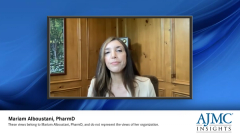
2023 Biosimilars Landscape
Drs Oskouei and Alboustani discuss implications of multiple biosimilars for adalimumab and how indications are extrapolated for a biosimilar.
Episodes in this series

Sonia T. Oskouei, PharmD, BCMAS, DPLA: The adalimumab biosimilars have a lot of attention and focus right now. As we get closer to 2023, when we'll see the launch of these products, the impact of having multiple adalimumab biosimilars is expected to be significant. Although it may take some time. There have been a lot of discussions around 2023 being a big year, which is because we will see the entrance of biosimilars, but the maximization of these products will take us into 2024 and maybe even 2025, if all the competitors on the market and the competition [are as predicted]. In terms of why or how we see the number of competitors we do for this molecule, it's not unexpected if we look at the top drugs by overall expenditure in the United States and globally. Adalimumab continues to be on that list and is the top drug by expenditure repeatedly over several years. In fact, probably one of the most interesting statements I saw recently was that this past year was the first time adalimumab was not the number 1 drug expenditure in the world and/or in the United States. That was defeated by the COVID-19 vaccine. That gives some perspective on how significant this product is and the big opportunity ahead as we have more competition coming to market with these biosimilars. I would say another impact of having adalimumab biosimilars come to market in the manner they are, with so many of them and with different quality attributes, is that we're having even more heightened attention on the US health care delivery model. We see a lot of discussions right now around policies, whether it's state or federal, around the reimbursement model, PBM [pharmacy benefit managers], and payers, and how the incentives are aligned or misaligned in the need for transparency. This dynamic, what we're seeing with a lot of biosimilars coming in for some of the costliest and most commonly used treatments, is further exposing the needs in US health care delivery to improve patient access and affordability for these critical treatments.
Mariam Alboustani, PharmD: For products without a specific indication approved in the reference product, such as adalimumab, there are several ways to drive utilization in the formulary. Let's address the FDA label indication, if it's in sync between the reference product and the interchangeable or biosimilar product. Although it is an added benefit, what we have seen in the last couple of years regarding biosimilar utilization specifically is that clinical guidelines play a big role in pushing that utilization of a biosimilar, even if that indication is not FDA approved for the biosimilar but FDA approved for the reference product. For example, a lot of these clinical guidelines would name the molecule and say, ‘this molecule is Level of Evidence A, or Level of Evidence I, or is firstline therapy.’ That is something we've seen a lot; therefore, providers and clinicians follow that guidance. An example is the American College of Rheumatology guideline, where it specifically says that biosimilars are equivalent to the FDA-approved originator. When it comes to DMARDs [disease-modifying antirheumatic drugs], it does not specify an FDA-indicated label. That's one aspect of looking at it and driving utilization. Another interesting and recent update came from CMS [Centers for Medicare and Medicaid Services] in November of 2021, where a memo touched on the subject and said that, where if the biosimilar does not overlap with the FDA-approved indication of the reference product, it is OK to use that biosimilar as long as there is clinical and treatment guideline support. As you can see, there are a lot of tools. There's a lot of clinical support for use of biosimilars even though the indication does not overlap with the reference product.
Sonia T. Oskouei, PharmD, BCMAS, DPLA: Extrapolation is the concept of approving a biosimilar for use in an indication that's held by the originator biologic but is not directly studied in a comparative trial with a biosimilar. Extrapolation occurs when a product is studied in the patient population in 1 key indication. Based on the totality of evidence, if the product is deemed to be highly similar, then there's extrapolation so the biosimilar can have the indications approved to all the other indications of the originator biologic. This is taking in the totality of evidence when the scientific concept of extrapolation occurs. This includes structural attributes, biological functions on non-clinical or toxicity studies, human PK [pharmacokinetic] or sometimes PD [pharmacodynamic] studies, taking in all these attributes of the molecule and testing it in a sensitive population. If all are deemed highly similar, then there's justification for extrapolation. What I also want to note here is that, overall, extrapolation is not a new or novel concept that came about with biosimilars. As biosimilars came to market, it opened up the need to go back and provide education and have discussions again on what biologics are and how these products are managed. An example of where extrapolation has been used for several years is if we look at manufacturing changes, and many biologics undergo manufacturing changes over the years. If there's a manufacturing change where the FDA deems there's a need to evaluate the impact of the change on the product's performance, it could result in a study of a sensitive population and in 1 indication. If all is deemed appropriate, they're highly similar, and there's no differences in performance, then there's that concept of extrapolation to support the use in all the other indications. This is an important area to understand that, again, it's not new to biosimilars, but it's also a key scientific principle to bringing biosimilars to market in the manner that they do. The accelerated approval pathway to bring biosimilars in this healthy competition to market is important when using extrapolation, reducing the need for any duplicative clinical studies, which would naturally add expenses, time, and resources to bring these products to market.
This transcript has been edited for clarity.
Newsletter
Stay ahead of policy, cost, and value—subscribe to AJMC for expert insights at the intersection of clinical care and health economics.

































































